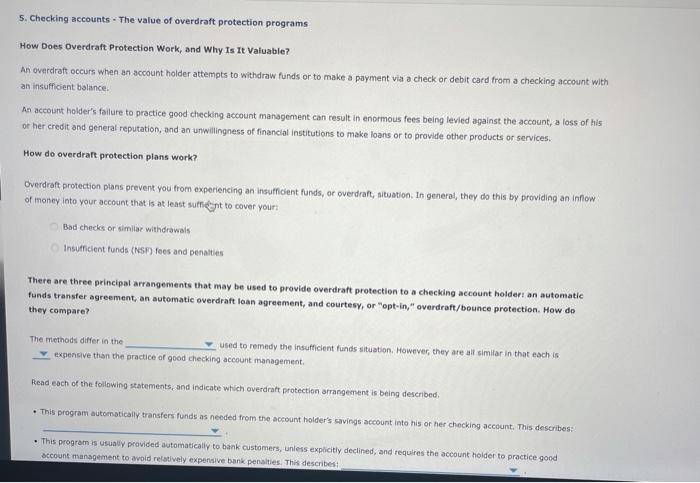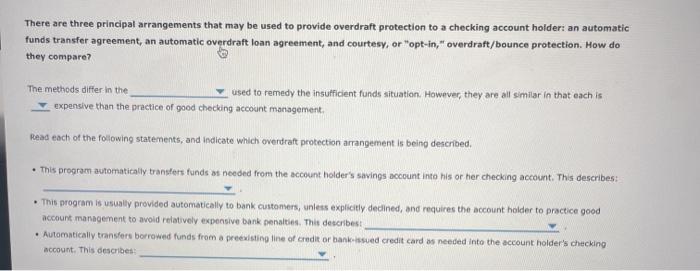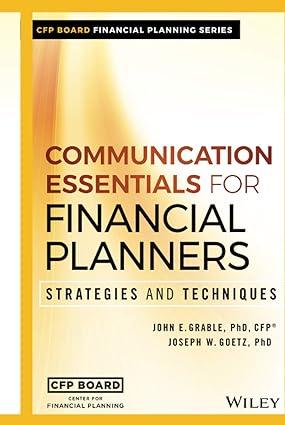5. Checking accounts - The value of overdraft protection programs How Does Overdraft Protection Work, and Why Is It Valuable? An overdraft occurs when an account holder attempts to withdraw funds or to make a payment via a check or debit card from a checking account with an insufficient balance An account holder's failure to practice good checking account management can result in enormous fees being levied against the account, a loss of his or her credit and general reputation, and an unwillingness of financial institutions to make loans or to provide other products or services. How do overdraft protection plans work? Overdraft protection plans prevent you from experiencing an insufficient funds, or overdraft, situation. In general, they do this by providing an inflow of money into your account that is at least suffient to cover your Bad checks or similar withdrawals Insufficient funds (NSF) fees and penalties There are three principal arrangements that may be used to provide overdraft protection to a checking account holder: an automatic funds transfer agreement, an automatic overdraft loan agreement, and courtesy, or "opt-in" overdraft/bounce protection. How do they compare? The methods differ in the used to remedy the insufficient funds situation. However, they are all similar in that each is expensive than the practice of good checking account management Read each of the following statements, and indicate which overdraft protection arrangement is being described . This program automatically transfers funds as needed from the account holder's savings account into his or her checking account. This describes: This program is usually provided automatically to bank customers, unless explicitly declined, and requires the account holder to practice good account management to avoid relatively expensive bank penalties. This describes There are three principal arrangements that may be used to provide overdraft protection to a checking account holder: an automatic funds transfer agreement, an automatic overdraft loan agreement, and courtesy, or "opt-in," overdraft/bounce protection. How do they compare? The methods differ in the used to remedy the insufficient funds situation. However, they are all similar in that each is expensive than the practice of good checking account management Read each of the following statements, and indicate which overdraft protection arrangement is being described. . This program automatically transfers funds as needed from the account holder's savings account into his or her checking account. This describes: This program is usually provided automatically to bank customers, unless explicitly dedined, and requires the account holder to practice good account management to avoid relatively expensive bank penalties. This describes Automatically transfers borrowed funds from a preexisting line of credit or bank-issued credit card as needed into the account holder's checking account. This describes 5. Checking accounts - The value of overdraft protection programs How Does Overdraft Protection Work, and Why Is It Valuable? An overdraft occurs when an account holder attempts to withdraw funds or to make a payment via a check or debit card from a checking account with an insufficient balance An account holder's failure to practice good checking account management can result in enormous fees being levied against the account, a loss of his or her credit and general reputation, and an unwillingness of financial institutions to make loans or to provide other products or services. How do overdraft protection plans work? Overdraft protection plans prevent you from experiencing an insufficient funds, or overdraft, situation. In general, they do this by providing an inflow of money into your account that is at least suffient to cover your Bad checks or similar withdrawals Insufficient funds (NSF) fees and penalties There are three principal arrangements that may be used to provide overdraft protection to a checking account holder: an automatic funds transfer agreement, an automatic overdraft loan agreement, and courtesy, or "opt-in" overdraft/bounce protection. How do they compare? The methods differ in the used to remedy the insufficient funds situation. However, they are all similar in that each is expensive than the practice of good checking account management Read each of the following statements, and indicate which overdraft protection arrangement is being described . This program automatically transfers funds as needed from the account holder's savings account into his or her checking account. This describes: This program is usually provided automatically to bank customers, unless explicitly declined, and requires the account holder to practice good account management to avoid relatively expensive bank penalties. This describes There are three principal arrangements that may be used to provide overdraft protection to a checking account holder: an automatic funds transfer agreement, an automatic overdraft loan agreement, and courtesy, or "opt-in," overdraft/bounce protection. How do they compare? The methods differ in the used to remedy the insufficient funds situation. However, they are all similar in that each is expensive than the practice of good checking account management Read each of the following statements, and indicate which overdraft protection arrangement is being described. . This program automatically transfers funds as needed from the account holder's savings account into his or her checking account. This describes: This program is usually provided automatically to bank customers, unless explicitly dedined, and requires the account holder to practice good account management to avoid relatively expensive bank penalties. This describes Automatically transfers borrowed funds from a preexisting line of credit or bank-issued credit card as needed into the account holder's checking account. This describes








